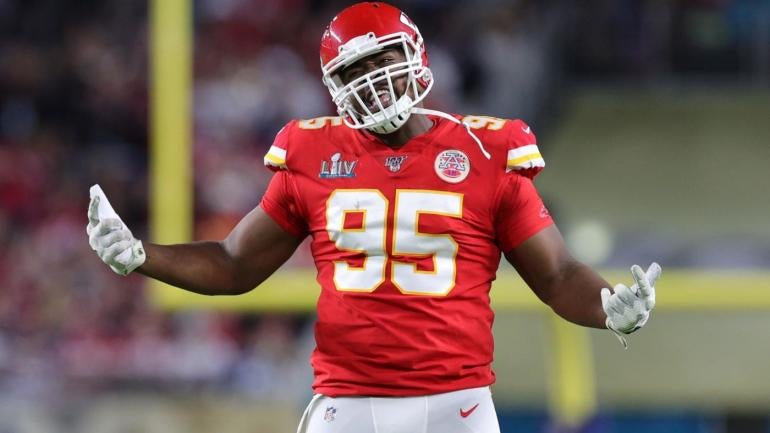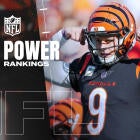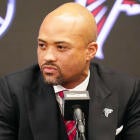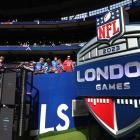
The Chiefs have one pressing matter to complete before trying to become the first team to repeat as Super Bowl champions since the 2004 Patriots. It's signing four-time Pro Bowl defensive tackle Chris Jones to a contract extension.
Jones subjected himself to a $98,753 fine for missing Kansas City's three-day mandatory minicamp last week because of his contract situation. Missing the June 15 championship ring ceremony initially prompted speculation about the depth of Jones' dissatisfaction with his contract before he explained on Twitter that he was sick. Some skeptics remain rather than taking Jones at face value.
Chiefs general manager Brett Veach expressed optimism regarding Jones at the ring ceremony. "We have great communication and there's a lot of time before camp," Veach said via FOX 4 News in Kansas City. "Feel good about where we're going to be with Chris. We'll get to celebrate tonight and have a good time, break tomorrow, and I'm sure we'll have great dialogue from now to the start of training camp and look forward to Chris being here not just for next year, but for a long time."
Jones is entering the final year of a four-year, $80 million contract (worth up to $85 million through incentives) with $60 million of guarantees he signed in 2020 as a franchise player. He is scheduled to make a $19.5 million base salary this season. His $28,291,668 salary cap number is the NFL's eighth largest for 2023 and fourth highest among defensive players.
Jones reportedly wants to at least be the league's second-highest-paid interior defensive lineman. Aaron Donald not only sets the market but is also the league highest-paid non-quarterback. The three-time NFL Defensive Player of the Year signed a three-year, $95 million contract, averaging $31,666,667 per year, last June.
Jones was hopeful that the young defensive tackles (Dexter Lawrence-Giants, Jeffery Simmons-Titans and Quinnen Williams-Jets), who were heading into the final year of rookie contracts, would "blow the market out" this offseason in the days leading up to Super Bowl LVII. That's because Jones knew he would reap the benefit of any changing market conditions.
Simmons is currently No. 2 in the interior defensive lineman salary hierarchy. He received a four-year, $94 million extension, averaging $23.5 million per year with $59.8 million of guarantees, in April. Williams is expected to help narrow the gap between Donald and the rest of the market with a deal upward to $25 million per year before the Jets open training camp in the latter part of July.
Jones should have leverage in the negotiations because he was the best interior defensive lineman last season, even before Donald was sidelined for the final six regular-season games with an ankle injury, and placing the franchise tag on him in 2024 will be too cost prohibitive. He tied a career high with 15.5 sacks. Jones' quarterback pressures (combined sacks, quarterback hurries and quarterback hits) were the fifth most in the NFL and led interior defensive linemen, according to Pro Football Focus. He earned All-Pro honors and was a finalist for the NFL Defensive Player of the Year award. Using a franchise tag on Jones next season will cost $33.6 million with the way the 120% salary increase provisions work with the designation.
A tight salary cap situation also cuts in Jones' favor. The Chiefs are slightly more than $1 million under the salary cap, according to NFLPA data. A Jones extension would be an optimal way to create more breathing room since reigning NFL MVP quarterback Patrick Mahomes' contract was already restructured for salary cap purposes in March.
Depending upon how a new Jones deal is structured, more than $10 million of salary cap space could be created. For example, giving Jones a $30 million signing bonus on a four-year extension while dropping his 2023 base salary from $19.5 million to $1.5 million would take his cap number from $28,291,668 to $16,291,668. The $30 million signing bonus would be prorated at $6 million annually on the salary cap from 2023 through 2027. An additional $1.25 million of cap room would be gained by removing Jones' likely to be earned incentive for reaching 10 sacks this season.
Jones potentially undercut his leverage when he wrote on Twitter in March, "I'm a Chief for life. I will not play for another franchise." If I had a client who made a statement like that while I was agent, I would implore him to retract the comment or at least qualify it. Jones to date has done neither.
Loyalty can be detrimental in a negotiation. Jones' sentiment can be interpreted by the Chiefs as he isn't willing to drive an extremely hard bargain, where he won't be adamant about topping Donald's $31,666,667 per year. The Chiefs probably view Donald's deal as an outlier anyway. I suspect Jones' "Chief for life" remark will be used against him in negotiations to try to get him to leave money on the table.
The Chiefs have had success in getting players who are or can be considered the best at their position to sign team-friendly deals.
The 10-year, $450 million extension worth up to $475 million with incentives Mahomes signed in 2020, which dramatically raised the bar for quarterback salaries with his $45 million average yearly salary, has become outdated. The contract was also extremely backloaded with the cash flow in the early years lagging well behind other high-end quarterback deals.
Mahomes is now the league's seventh-highest-paid player after Eagles quarterback Jalen Hurts and Ravens quarterback Lamar Jackson recently signed contracts averaging $51 million and $52 million per year. He will likely soon drop to ninth as the Bengals and Chargers are expected to give new deals to 2020 first-round picks Joe Burrow (first overall) and Justin Herbert (sixth overall) at some point before the 2023 regular season starts. The Chiefs have acknowledged that an adjustment to Mahomes' contract is going to be necessary because of the growth in quarterback salaries.
Perennial All-Pro tight end Travis Kelce signed a four-year extension in 2020, averaging $14,312,500 per year, that made him the league's second-highest-paid tight end when he had two years left on his contract. His 2020 compensation remained the same, which was unusual for a deal of this magnitude. Kelce only got $4.25 million more over his remaining two years than if he played out the 2016 extension.
A "pay as you go" contract structure was used where a player's cash and salary cap numbers are the same in each contract year because there isn't a signing bonus that would be prorated over the life of the contract (for a maximum of five years). Surprisingly, Kelce had minimal guaranteed money after the second year of the deal (2021). The lack of guarantees and a signing bonus gave the Chiefs maximum flexibility to exit the deal as early as 2022 without any salary cap consequences if Kelce's skills had rapidly started to diminish, which they obviously haven't. Kelce's contract was so backloaded that he was given a $3 million raise last year in which his 2023 and 2024 compensation was reduced by a corresponding amount.
Jones may want to wait until Williams signs to have more complete information about the interior defensive lineman market, especially since Jets head coach Robert Saleh has expressed confidence that a deal will be done by the start of training camp. The Jets open training camp earlier than other teams because they are playing the Browns in the Hall of Fame Game on Aug. 3.
A Jones deal shouldn't be less than the approximate midpoint of Donald and the second-highest-paid interior defensive lineman. This would be right around $27.5 million per year with Williams being unable to beat Simmons' $23.5 million per year. At this salary level, the overall salary guarantees should at least be in the $70 million neighborhood with around $55 million fully guaranteed at signing based on Simmons' and Lawrence's deals. Jones insisting on joining Donald as a $30 million-per-year interior defensive lineman wouldn't be unreasonable.
How a Jones deal is structured remains to be seen. Jones made some structural concessions with his current contract. The cash in the first year equaled his franchise tag. This was in stark contrast to edge rusher Justin Houston getting 63% more than his franchise tag from the Chiefs in the first year when he signed a long-term deal five years earlier. Jones also had just over 47% of the money in the first two years, which made his four-year deal slightly backloaded.





















